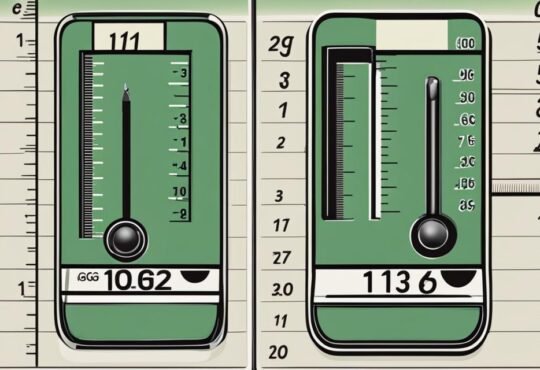
Convert 126g to kg – Quick & Easy Weight Guide
Welcome to our quick and easy weight guide, where we’ll show you how to convert 126 grams to kilograms effortlessly. Whether you’re following a recipe or you just need to know the weight in a different unit, we’ve got you covered!
Converting grams to kilograms is a simple process. All you need to do is divide the weight in grams by 1000. So, to convert 126 grams to kilograms, you would divide 126 by 1000. The result is 0.126 kilograms.
But don’t worry, if math isn’t your strong suit, we’ve created a handy calculator to make it even easier for you. Just enter the weight in grams, and our calculator will do the conversion for you.
Now that you know how to convert 126 grams to kilograms, let’s explore some key takeaways to keep in mind:
Contents
- 1 Why do you need protein?
- 2 How much protein do you actually need?
- 3 Different ways to track protein intake
- 4 Simple swaps to boost protein intake
- 5 How to structure your training routine for optimal results
- 6 The role of cardio in weight loss and body composition
- 7 Conclusion
- 8 FAQ
- 8.1 How do I convert 126 grams to kilograms?
- 8.2 What is the importance of protein in the body?
- 8.3 How much protein do I actually need?
- 8.4 What are different ways to track protein intake?
- 8.5 How can I boost my protein intake?
- 8.6 How should I structure my training routine for optimal results?
- 8.7 What is the role of cardio in weight loss and body composition?
- 8.8 What is the conclusion?
Key Takeaways
- Converting grams to kilograms is as simple as dividing the weight in grams by 1000.
- For example, 126 grams is equal to 0.126 kilograms.
- Use our handy calculator for quick and accurate conversions.
- Understanding weight conversions can be helpful in various situations, from cooking to everyday measurements.
- Now you can confidently convert grams to kilograms whenever the need arises.
Why do you need protein?
Protein is an essential macronutrient that plays a crucial role in the body. It offers a wide range of benefits and is vital for overall health and well-being. Let’s explore the various roles that protein plays in our bodies:
- Importance of Protein in the Body: Protein is necessary for the growth, development, and repair of tissues in the body. It is involved in numerous biological processes and is a key component of enzymes, hormones, and antibodies.
- Protein’s Role in Digestion: Proteins are broken down into amino acids during the digestion process, which are then absorbed by the body and used for various functions.
- Protein’s Role in Structure and Maintenance: Proteins provide structure and strength to various parts of the body, such as bones, ligaments, hair, skin, and lungs. They also contribute to the maintenance and repair of these structures.
- Protein’s Role in Fighting Illness and Infection: Certain proteins act as antibodies, helping to defend the body against illness and infection. They play a crucial role in the immune system’s response.
- Protein’s Role in Hormone Production: Proteins are involved in the production of hormones, which regulate various bodily functions such as metabolism, growth, and reproduction.
- Protein’s Role in Tissue Growth and Maintenance: Protein is essential for tissue growth and maintenance, especially in muscles. It helps repair damaged tissues and supports muscle development.
Overall, protein is a foundational component of our bodies and has a profound impact on our health. By including protein-rich foods in our diet, we can ensure adequate intake and avail the numerous benefits it offers.
How much protein do you actually need?
The recommended protein intake varies based on several factors, including age, height, weight, gender, and activity level. It’s important to determine your individual protein needs to support your overall health and fitness goals.
Some experts suggest that consuming 0.36-0.5 grams of protein per pound of body weight is sufficient, while others recommend a range of 0.8-1.2 grams per kilogram of body weight. These guidelines can vary depending on specific circumstances and objectives.
To ensure an adequate protein intake, it’s advisable to aim for 25-30% of your total daily calories coming from protein. This percentage allows for a balanced diet that includes other essential nutrients.
Factors such as physical activity, muscle mass, and medical conditions can also influence protein requirements. Athletes or individuals engaged in regular vigorous exercise may need more protein to support muscle repair and growth.
Women may have slightly different protein needs compared to men due to variations in body composition. Pregnancy and breastfeeding can also increase protein requirements for women.
Keep in mind that these guidelines are generalized recommendations, and consulting with a healthcare professional or registered dietitian can help you determine the optimal protein intake for your specific needs.
| Factors Affecting Protein Needs | Recommended Protein Intake |
|---|---|
| Age | Varies based on life stage and requirements |
| Height | No significant impact on protein needs |
| Weight | 0.36-0.5 grams per pound or 0.8-1.2 grams per kilogram |
| Gender | May vary slightly; women may have higher needs during pregnancy and breastfeeding |
| Activity Level | May require more protein for individuals engaging in regular intense exercise |
| Muscle Mass | Higher protein needs for individuals with greater muscle mass |
| Medical Conditions | Specific medical conditions may require adjustments in protein intake |
Remember, individual protein needs can vary, so it’s essential to listen to your body and make adjustments as necessary. Finding the right balance of protein in your diet can help support muscle growth, repair, and overall health.
Different ways to track protein intake
When it comes to tracking your protein intake, there are several methods you can choose from, each with its own pros and cons. Let’s take a closer look at three popular approaches: calorie counting, macro counting, and intuitive eating.
Calorie Counting
Calorie counting is a straightforward method that focuses on tracking your overall calorie intake, including the calories from protein. This approach provides a clear picture of your energy balance and can be a good starting point for those who are new to nutrition. By monitoring your calories, you can ensure that you’re consuming enough protein to support your health and fitness goals. However, this method may not provide a detailed breakdown of your macronutrient ratios.
Macro Counting
Macro counting involves tracking the ratio of carbohydrates, fats, and protein in your diet. This method allows for a more holistic understanding of your nutrition and enables you to adjust your macronutrient intake based on your goals. By setting specific protein targets, you can ensure that you’re meeting your daily protein needs. Macro counting can be beneficial for individuals who want precise control over their macronutrient ratios. However, it can be time-consuming and requires careful tracking of your food intake.
Intuitive Eating
Intuitive eating takes a different approach by emphasizing listening to your body’s hunger cues and cravings. With this method, you’re encouraged to eat when you’re hungry and stop eating when you’re full, while still considering your calorie and macronutrient needs. Intuitive eating promotes a positive relationship with food and can help you develop a sustainable and balanced approach to nutrition. However, it may be challenging to accurately measure your protein intake with intuitive eating alone.
Each method has its benefits and may work differently for individuals. Some people find success with calorie counting, while others prefer the more detailed approach of macro counting. Intuitive eating can be a helpful practice for developing a healthy relationship with food. Ultimately, the best approach is one that aligns with your goals, preferences, and lifestyle.
| Method | Pros | Cons |
|---|---|---|
| Calorie counting | – Provides overall calorie control – Beginner-friendly |
– May not show detailed macronutrient breakdown |
| Macro counting | – Offers precise macronutrient control – Allows customization based on goals |
– Requires accurate food tracking – Time-consuming |
| Intuitive eating | – Promotes a positive relationship with food – Focuses on hunger and fullness cues |
– Difficult to measure precise protein intake |
Simple swaps to boost protein intake
Making simple swaps in your diet can help increase your protein intake. By choosing protein-rich food swaps, you can enjoy delicious meals while meeting your protein needs. Here are some options to consider:
| Regular Choice | Protein-Rich Swap |
|---|---|
| Regular pasta | High-protein pasta |
| Regular flour tortillas | High-protein tortillas |
| White bread | Whole wheat bread |
| (made with chickpea flour) |
When it comes to pasta, opt for high-protein alternatives like chickpea pasta. It not only offers the same delicious taste and texture but also provides more protein per serving. Similarly, replace regular flour tortillas with high-fiber or almond flour tortillas, which are protein-rich options and can be enjoyed in various wraps and dishes. Lastly, choose multigrain or whole wheat bread made with chickpea flour instead of white bread for a more protein-packed sandwich or toast.
These simple food swaps allow you to include more protein in your meals without sacrificing taste or variety. Experiment with these protein-rich options and discover new flavors while meeting your nutritional needs.
How to structure your training routine for optimal results
Structuring your training routine is essential for achieving optimal results in your fitness journey. By incorporating training splits, upper body push/pull days, core workouts, and leg workouts into your routine, you can effectively target and strengthen different areas of your body.
Training Splits
When it comes to training splits, it’s important to divide your workout sessions based on specific muscle groups. This allows you to focus on one or two muscle groups per session, giving them ample time to recover before the next training day. Common training splits include:
- Upper body and lower body split
- Push and pull split
- Body part split (e.g., chest and triceps, back and biceps, legs)
Choose a training split that suits your goals and preferences, and make sure to incorporate rest days for proper recovery.
Upper Body Push/Pull Days
Including upper body push/pull days in your routine helps to target and strengthen muscles in the chest, shoulders, triceps, back, and biceps. On push days, you focus on exercises that involve pushing movements, such as chest presses and shoulder presses. On pull days, you engage in exercises that involve pulling movements, such as rows and pull-ups. This balanced approach ensures that all muscles in the upper body are trained effectively.
Core Workouts
A strong core is essential for overall strength, stability, and posture. Core workouts typically target the abdominal muscles, obliques, and lower back. Incorporate exercises such as planks, Russian twists, and bicycle crunches into your routine to engage and strengthen your core. A strong core not only improves athletic performance but also helps protect against injuries.
Leg Workouts
Leg workouts are crucial for building lower body strength and improving functional movement. Include exercises that target the quadriceps, hamstrings, and calves, such as squats, lunges, deadlifts, and calf raises. Leg training not only enhances your physique but also supports overall stability and balance.
By structuring your training routine to include training splits, upper body push/pull days, core workouts, and leg workouts, you can effectively target and strengthen different areas of your body. Incorporate a variety of exercises and continuously challenge yourself to achieve optimal results in your fitness journey.
The role of cardio in weight loss and body composition
Cardiovascular exercise, commonly referred to as cardio, is a valuable tool for weight loss and improving body composition. While cardio is effective at burning calories and promoting weight loss, it is equally important to incorporate strength training into your fitness routine. Strength training not only helps to build muscle but also increases your resting metabolism, resulting in a higher calorie burn even at rest.
To understand the benefits of cardio for weight loss, it’s important to first grasp the concept of a calorie deficit. A calorie deficit occurs when you consume fewer calories than your body needs to maintain its current weight. By incorporating cardio exercises into your routine, such as running, cycling, or swimming, you can increase your calorie expenditure and create a larger calorie deficit. This can lead to weight loss over time.
However, weight loss is not the only factor to consider when improving body composition. Body composition refers to the ratio of fat to muscle in your body. Strength training plays a crucial role in changing body composition by increasing lean muscle mass. Unlike fat, muscle is metabolically active, meaning it burns more calories at rest. By incorporating strength training exercises like weightlifting or bodyweight exercises, you can build and maintain muscle mass, which in turn helps to improve body composition.
It’s important to note that focusing solely on cardio for weight loss may result in muscle loss along with fat loss. This can lead to a decrease in resting metabolism and potential weight regain. By combining cardio and strength training, you can maximize weight loss while preserving and building lean muscle mass.
Strength training also offers several additional benefits. It can help increase bone density, improve joint stability, enhance functional fitness, and decrease the risk of injury. Furthermore, strength training can promote a toned and sculpted physique, improving body shape and overall aesthetics.
While cardio is an essential component of any weight loss journey, it is crucial to complement it with strength training for optimal body composition results. By incorporating both types of exercise into your routine and maintaining a calorie deficit, you can achieve long-term weight loss and improve your overall body composition.
The Benefits of Cardio for Weight Loss and Body Composition:
- Burns calories, aiding in weight loss
- Increases cardiovascular endurance and overall fitness
- Improves heart health and reduces the risk of chronic diseases
- Reduces stress and improves mental well-being
The Benefits of Strength Training for Weight Loss and Body Composition:
- Builds muscle and increases resting metabolism
- Improves body shape, tone, and aesthetics
- Increases bone density and joint stability
- Enhances functional fitness and reduces the risk of injury
In summary, while cardio is effective for weight loss, combining it with strength training offers numerous benefits for body composition and overall health. By creating a calorie deficit through cardio exercises and building lean muscle mass through strength training, you can achieve lasting weight loss and sculpt a strong, toned physique.
Conclusion
By understanding the importance of protein, determining your individual protein needs, and implementing effective training and nutrition strategies, you can optimize your health, fitness, and weight management goals. Protein plays a crucial role in digestion, structure and maintenance, fighting illness and infection, hormone production, and tissue growth and maintenance. It also promotes satiety and boosts metabolism.
To achieve your desired physique and performance, experiment with different methods of tracking protein intake and find what works best for you. Whether it’s calorie counting, macro counting, or intuitive eating, tracking your protein intake can help ensure you’re meeting your goals. Additionally, make simple swaps in your diet to increase protein intake. Choose high-protein alternatives like chickpea pasta, high-fiber tortillas, and whole wheat bread.
Finally, structure your training routine for maximum results. Incorporate upper body push/pull days, core workouts, and leg workouts to effectively target and strengthen different areas of your body. Remember, achieving your goals requires dedication and consistency. Stay committed to your journey, enjoy the process, and celebrate your progress along the way. You’ve got this!
FAQ
How do I convert 126 grams to kilograms?
To convert 126 grams to kilograms, divide the weight in grams by 1000. In this case, 126 grams divided by 1000 equals 0.126 kilograms.
What is the importance of protein in the body?
Protein is an essential macronutrient that plays a crucial role in digestion, blood clotting, energy production, muscle contraction, and the structure and maintenance of various body tissues. It also helps fight illness and infection, acts as hormones, promotes tissue growth and maintenance, boosts metabolism, balances blood glucose levels, and aids in satiety.
How much protein do I actually need?
Recommended protein intake varies based on factors like age, height, weight, gender, and activity level. Some experts suggest consuming 0.36-0.5 grams of protein per pound of body weight, while others recommend 0.8-1.2 grams per kilogram of body weight. Individual protein needs can differ, so it’s best to aim for 25-30% of total daily calories coming from protein.
What are different ways to track protein intake?
There are several methods to track protein intake, each with its advantages and disadvantages. Calorie counting focuses on overall calorie intake and is a good starting point for beginners. Macro counting involves tracking the ratio of carbs, fats, and protein in the diet and provides a more holistic understanding of nutrition. Intuitive eating emphasizes listening to hunger cues while considering calories and macros. Experiment with different methods and find what works best for you.
How can I boost my protein intake?
Making simple swaps in your diet can help increase protein intake. Consider choosing high-protein alternatives such as chickpea pasta, high-fiber or almond flour tortillas, and multigrain or whole wheat bread. These swaps provide more protein while still offering delicious meal options.
How should I structure my training routine for optimal results?
To achieve optimal results, consider incorporating upper body push/pull days, core workouts, and leg workouts into your routine. Upper body training targets chest, shoulders, triceps, back, and biceps muscles. Core training strengthens abdominal, oblique, and lower back muscles. Leg training focuses on quadriceps, hamstrings, and calves. By dividing your training into specific muscle groups, you can effectively target and strengthen different areas of your body.
What is the role of cardio in weight loss and body composition?
Cardio is effective for burning calories and can aid in weight loss. However, strength training is equally important for changing body composition. Strength training builds muscle, which increases resting metabolism and burns more calories in the long run. Combining cardio with strength training can result in better overall body composition and help maintain weight loss.
What is the conclusion?
By understanding the importance of protein, determining your individual protein needs, and implementing effective training and nutrition strategies, you can optimize your health, fitness, and weight management goals. Experiment with different methods of tracking protein intake and find what works best for you. Remember to make simple swaps in your diet to increase protein intake and structure your training routine for maximum results. Achieving your desired physique and performance requires dedication and consistency. Stay committed to your journey and enjoy the process.







